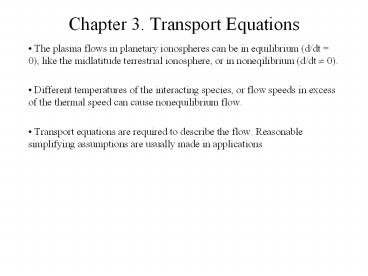Chapter 3. Transport Equations - PowerPoint PPT Presentation
Title:
Chapter 3. Transport Equations
Description:
Chapter 3. Transport Equations The plasma flows in planetary ionospheres can be in equilibrium (d/dt = 0), like the midlatitude terrestrial ionosphere, or in ... – PowerPoint PPT presentation
Number of Views:99
Avg rating:3.0/5.0
Title: Chapter 3. Transport Equations
1
Chapter 3. Transport Equations
- The plasma flows in planetary ionospheres can be
in equilibrium (d/dt 0), like the midlatitude
terrestrial ionosphere, or in noneqilibrium (d/dt
? 0). - Different temperatures of the interacting
species, or flow speeds in excess of the thermal
speed can cause nonequilibrium flow. - Transport equations are required to describe the
flow. Reasonable simplifying assumptions are
usually made in applications
2
3.1 Boltzmann Equation (1)
- Boltzmanns probability density fs for each
species s. - The number of particles in a phase space
volume element d3r d3v is fs d3r d3vs.
3
3.1 Boltzmann Equation (2)
- If there are collisions, the densities in phase
space will change, dfs/dt ?fs/?t (Boltzmann
collision integral), resulting in the Boltzmann
equation
4
3.2 Velocity Moments of Distribution Functions (1)
5
Velocity Moments of Distribution Functions (2)
6
Moments of Distribution Functions (3)
7
Moments of Distribution Functions (4)
8
3.3 Transport Equations (1)
- We can use the Boltzmann equation to describe the
evolution in space and time of the physically
important velocity moments. - Use the following relation to rewrite the
Boltzmann equation
9
3.3 Transport Equations (2)
- Miraculously we can use the Boltzmann equation
(BE) to derive the continuity and momentum
equations. Integrating BE over all velocities
gives
10
3.3 Transport Equations (3)
- To obtain the momentum equation we multiply the
BE with mscs and integrate over all velocities.
11
3.3 Transport Equations (4)
12
3.3 Transport Equations (5)
13
3.3 Transport Equations (6)
- This leaves
14
3.3 Transport Equations (7)
15
Discussion of Transport Equations (8)
- The momentum equation describes the evolution of
the first-order velocity momentum us in terms of
the second-order momentum Ps. Similarly the
continuity equation describes the evolution of
the density ns (zero-order momentum) using the
first-order velocity momentum us, etc. This
means, the transport equations are not a closed
system. - To close the system we need an approximate
distribution function fs(r,vs,t). We will use the
local drifting Maxwellian.
16
3.4 Maxwellian Velocity Distribution Function (1)
- When collisions dominate, the distribution
function becomes Maxwellian (no prove given
here). In the following I suppress the species
subscript s.
17
Maxwellian Velocity Distribution Function (2)
18
Maxwellian Velocity Distribution Function (3)
19
3.5 Closing the System of Transport Equations (1)
- To close the system of transport equations we
need a function f. One generally uses an
orthogonal series expansion for f as shown below
20
3.5 Closing the System of Transport Equations (2)
21
3.6 Maxwell Equations
- The electric and magnetic fields E and B in a
medium are related by Maxwells equations
22
(No Transcript)































